Frederick Blakeslee painted all the covers for the entire run of Dare-Devil Aces. And each of those covers had a story behind it. The February 1937 Dare-Devil Aces’ cover is the first of Mr. Blakeslee’s “Planes by the Numbers” covers where he has so many planes on the cover, he explains which plane is what with a legend on the story behind the cover page. He featured the Hawker Fury on the previous issue—on this issue he featured the other planes in the Hawker line of fighters.
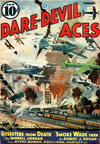 SOME very particular gent wrote to me the other day. complaining about the covers. He yelled that I took too much liberty with facts, and grouped planes that seldom, if ever, are seen together. He must be a new reader, for I have oft stated that, as this magazine is a fictional enterprise, the covers try to keep pace with the contents. Of course the covers are slightly screwy! I’m afraid that they wouldn’t be very interesting if I showed you a squadron of planes that were exactly alike in every respect.
SOME very particular gent wrote to me the other day. complaining about the covers. He yelled that I took too much liberty with facts, and grouped planes that seldom, if ever, are seen together. He must be a new reader, for I have oft stated that, as this magazine is a fictional enterprise, the covers try to keep pace with the contents. Of course the covers are slightly screwy! I’m afraid that they wouldn’t be very interesting if I showed you a squadron of planes that were exactly alike in every respect.
This month’s cover is an example of what I mean. About seven types of planes are represented, and although some of them are slightly out of place, I don’t think you’ll mind. Let me tell you about them.
You’ll notice that the silhouettes on this page are really ships on the cover, set in exactly the same positions.
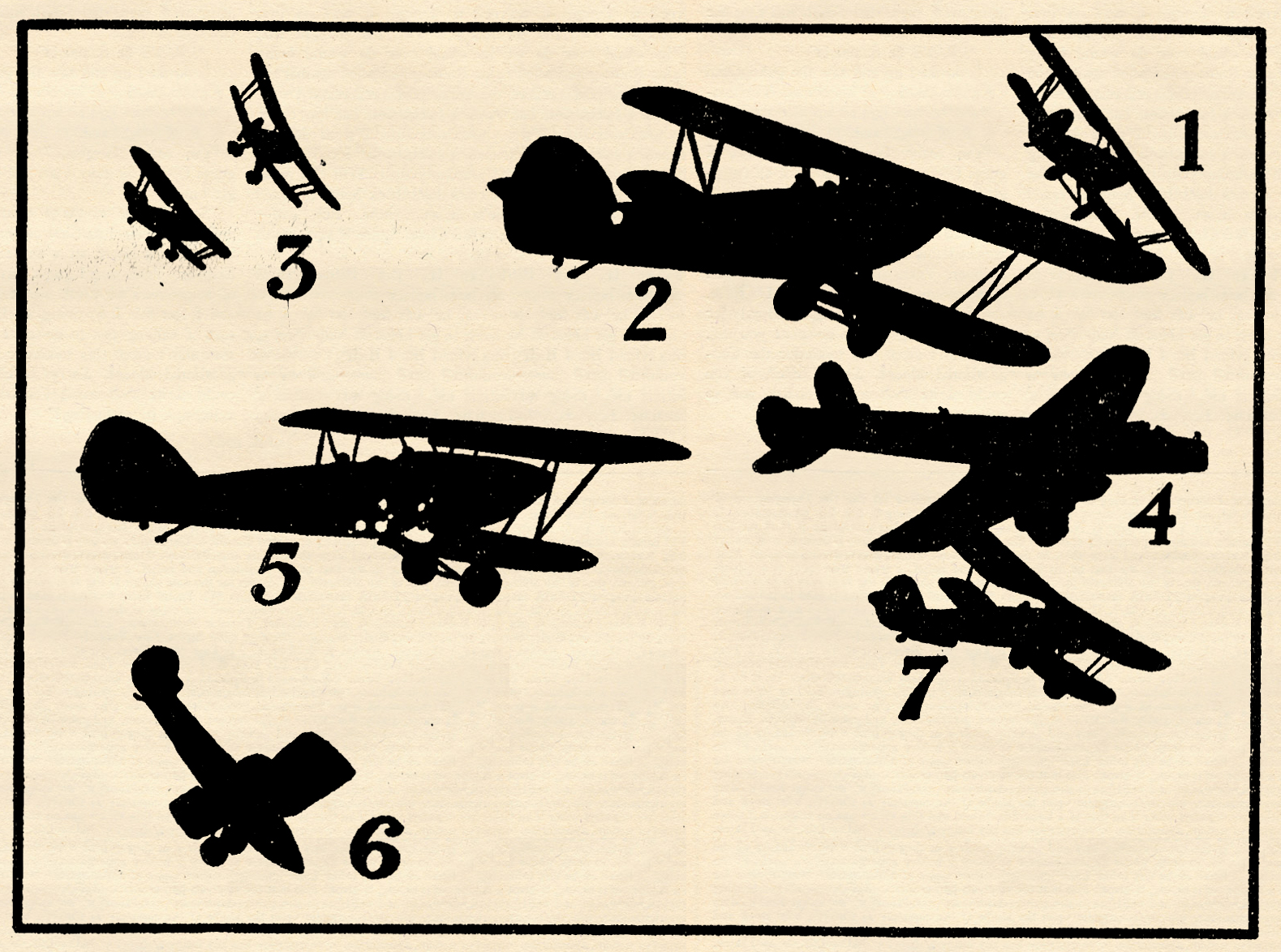
No. 1 is the Hawker “Osprey”, a Fleet fighter that ordinarily operates from aircraft carriers and other ships of the Royal Navy. I don’t know just what it’s doing over the city. Maybe the guy is on leave. It has a top speed of 240 m.p.h.
No. 2 is a Hawker “Hart”, the standard single-engined day bomber of the R.F.A. It is the basic type for most of the other Hawkers, and does 184 m.p.h.
No. 3, there are two of them, are German Ardo fighters.
No. 4 is a Fairey “Hendon” night bomber, and don’t ask me what it’s doing out in the daytime. Maybe it hasn’t been home yet. You’ll notice that it has left the rest of the flight and is off by itself. Ginsburg is probably at the wheel, and you know that guy!
No. 5 is a Hawker “Hardy”, a general purpose biplane that is particularly adapted for use in India and the Near East. Details are lacking on this, however.
No. 6 is a Hawker “Audax”, an Army cooperation crate with a speed of 152 m.p.h., which is practically walking. The way it’s heading now, the pilot would have done better to stay in bed.
No. 7 is a Bristol “Bulldog”, a really high-class piece of business. It does 175 m.p.h. at sea level, and 218 m.p.h. at 20,000, which is really lugging the mail.
So look them over, gents, and remember that I warned you.
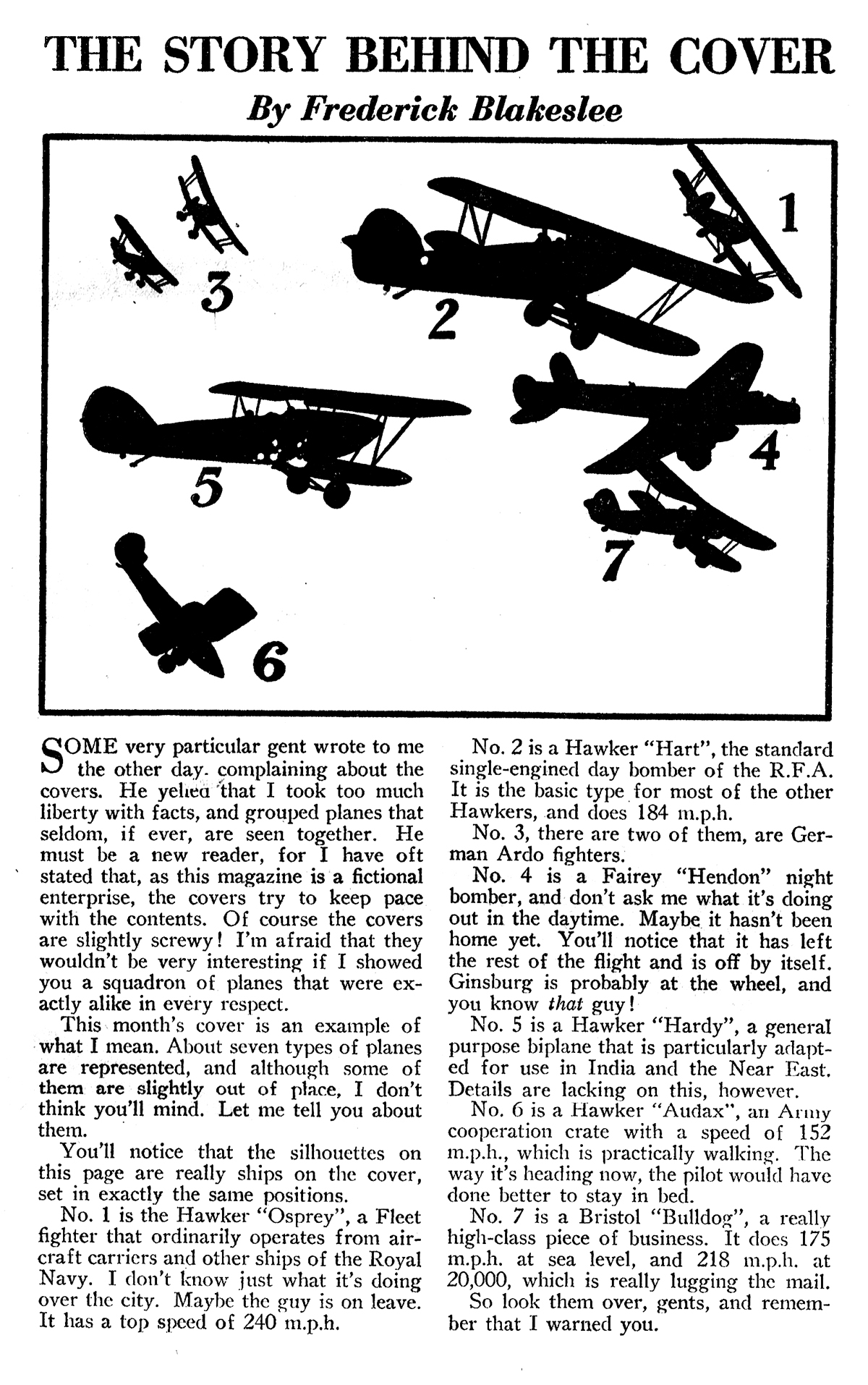
“The Story Behind The Cover” by Frederick Blakeslee
(February 1937, Dare-Devil Aces)
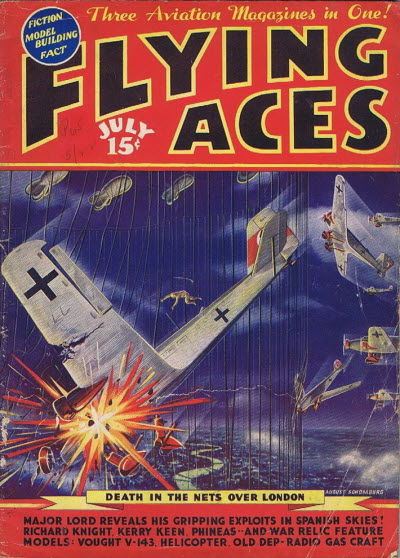 You heard right! That sound can only mean one thing—that Bachelor of Artifice, Knight of Calamity and an alumnus of Doctor Merlin’s Camelot College for Conjurors is back. Yes it’s the marvel from Boonetown, Iowa himself—Lieutenant Phineas Pinkham—and he goes to Gay Paree in this latest Roar! You’ve read about Fraulein Doktor—well, Pinkham runs afoul of one of her protégées, Fraulein Interne, and tries to thwart her dastardly plans!
You heard right! That sound can only mean one thing—that Bachelor of Artifice, Knight of Calamity and an alumnus of Doctor Merlin’s Camelot College for Conjurors is back. Yes it’s the marvel from Boonetown, Iowa himself—Lieutenant Phineas Pinkham—and he goes to Gay Paree in this latest Roar! You’ve read about Fraulein Doktor—well, Pinkham runs afoul of one of her protégées, Fraulein Interne, and tries to thwart her dastardly plans!








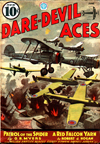

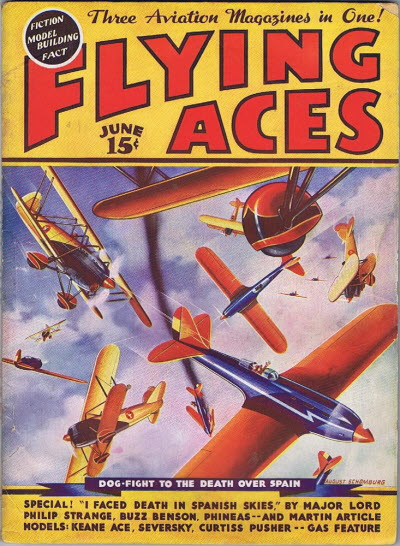 That sound can only mean one thing—it’s time to ring out the old year and ring in the new with that Bachelor of Artifice, Knight of Calamity and an alumnus of Doctor Merlin’s Camelot College for Conjurors—Phineas Pinkham. The Boonetown miracle is sent to Bagdad to find out the lay of the land between Bagdad and Mosul—the strength of Turkish troops, the number of guns, and all that sort of thing. But most important of all, he is to ferret out the Turkish spy—Mustapha Murad. It is a dangerous job, that Phineas accomplishes in his own inimitable style. It’s the Arabian Nights a’la Phineas Pinkham! From the pages of the June 1937 issue of Flying Aces, it’s “Bagged in Bagdad!”
That sound can only mean one thing—it’s time to ring out the old year and ring in the new with that Bachelor of Artifice, Knight of Calamity and an alumnus of Doctor Merlin’s Camelot College for Conjurors—Phineas Pinkham. The Boonetown miracle is sent to Bagdad to find out the lay of the land between Bagdad and Mosul—the strength of Turkish troops, the number of guns, and all that sort of thing. But most important of all, he is to ferret out the Turkish spy—Mustapha Murad. It is a dangerous job, that Phineas accomplishes in his own inimitable style. It’s the Arabian Nights a’la Phineas Pinkham! From the pages of the June 1937 issue of Flying Aces, it’s “Bagged in Bagdad!”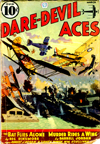
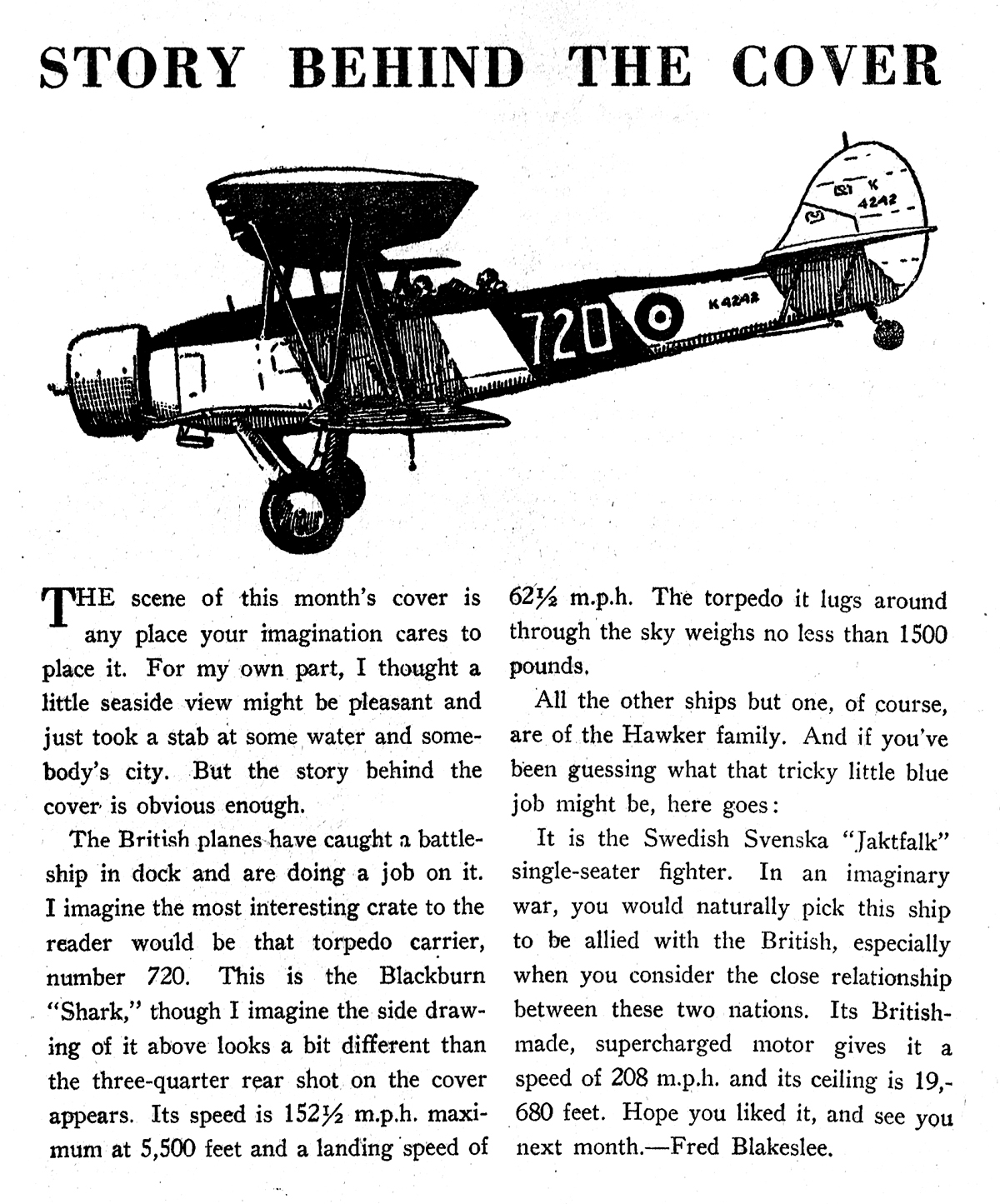



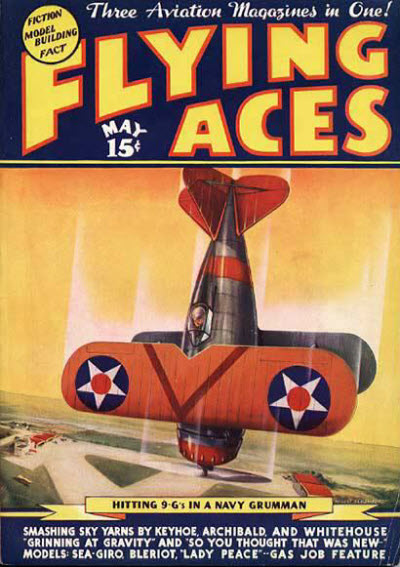 That sound can only mean one thing—it’s time to ring out the old year and ring in the new with that Bachelor of Artifice, Knight of Calamity and an alumnus of Doctor Merlin’s Camelot College for Conjurors—Phineas Pinkham.
That sound can only mean one thing—it’s time to ring out the old year and ring in the new with that Bachelor of Artifice, Knight of Calamity and an alumnus of Doctor Merlin’s Camelot College for Conjurors—Phineas Pinkham. 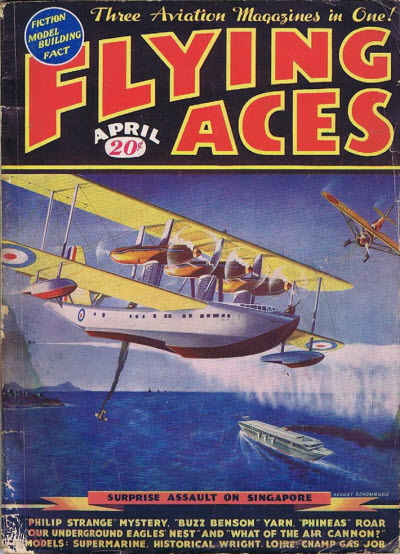 That sound can only mean one thing—that marvel from Boonetown, Iowa is back causing more trouble than he’s worth! During the last year of the colossal fuss the Italian board of strategy powwowed at Padua and came to the conclusion that something had to be done about the Austro threat across the Piave and sent out an S.O.S. to the western front calling for a triple threat airman who would be able to cope with one Baron von Zweibach who had become widely known from the Dardanelles to the Dover Straits as “The Caproni Crusher.” The only way to fight a triple treat is with a triple threat, so Wing sent that jinx to Jerries to Italy! It’s another Phineas Pinkham laugh panic from the pages of the April 1937 Flying Aces!
That sound can only mean one thing—that marvel from Boonetown, Iowa is back causing more trouble than he’s worth! During the last year of the colossal fuss the Italian board of strategy powwowed at Padua and came to the conclusion that something had to be done about the Austro threat across the Piave and sent out an S.O.S. to the western front calling for a triple threat airman who would be able to cope with one Baron von Zweibach who had become widely known from the Dardanelles to the Dover Straits as “The Caproni Crusher.” The only way to fight a triple treat is with a triple threat, so Wing sent that jinx to Jerries to Italy! It’s another Phineas Pinkham laugh panic from the pages of the April 1937 Flying Aces!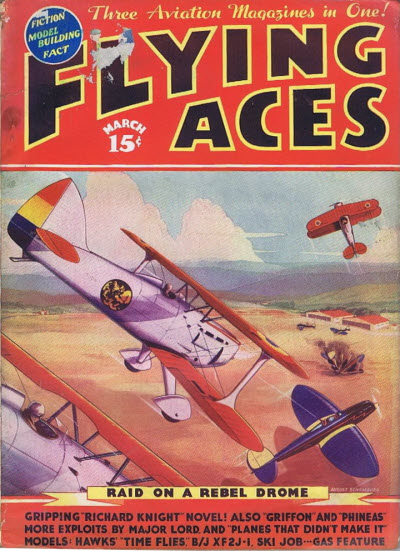 That sound can only mean one thing—that Bachelor of Artifice, Knight of Calamity and an alumnus of Doctor Merlin’s Camelot College for Conjurors is back to vex not only the Germans, but the Americans—the Ninth Pursuit Squadron in particular—as well. Yes it’s the marvel from Boonetown, Iowa himself—Lieutenant Phineas Pinkham!
That sound can only mean one thing—that Bachelor of Artifice, Knight of Calamity and an alumnus of Doctor Merlin’s Camelot College for Conjurors is back to vex not only the Germans, but the Americans—the Ninth Pursuit Squadron in particular—as well. Yes it’s the marvel from Boonetown, Iowa himself—Lieutenant Phineas Pinkham! 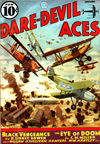
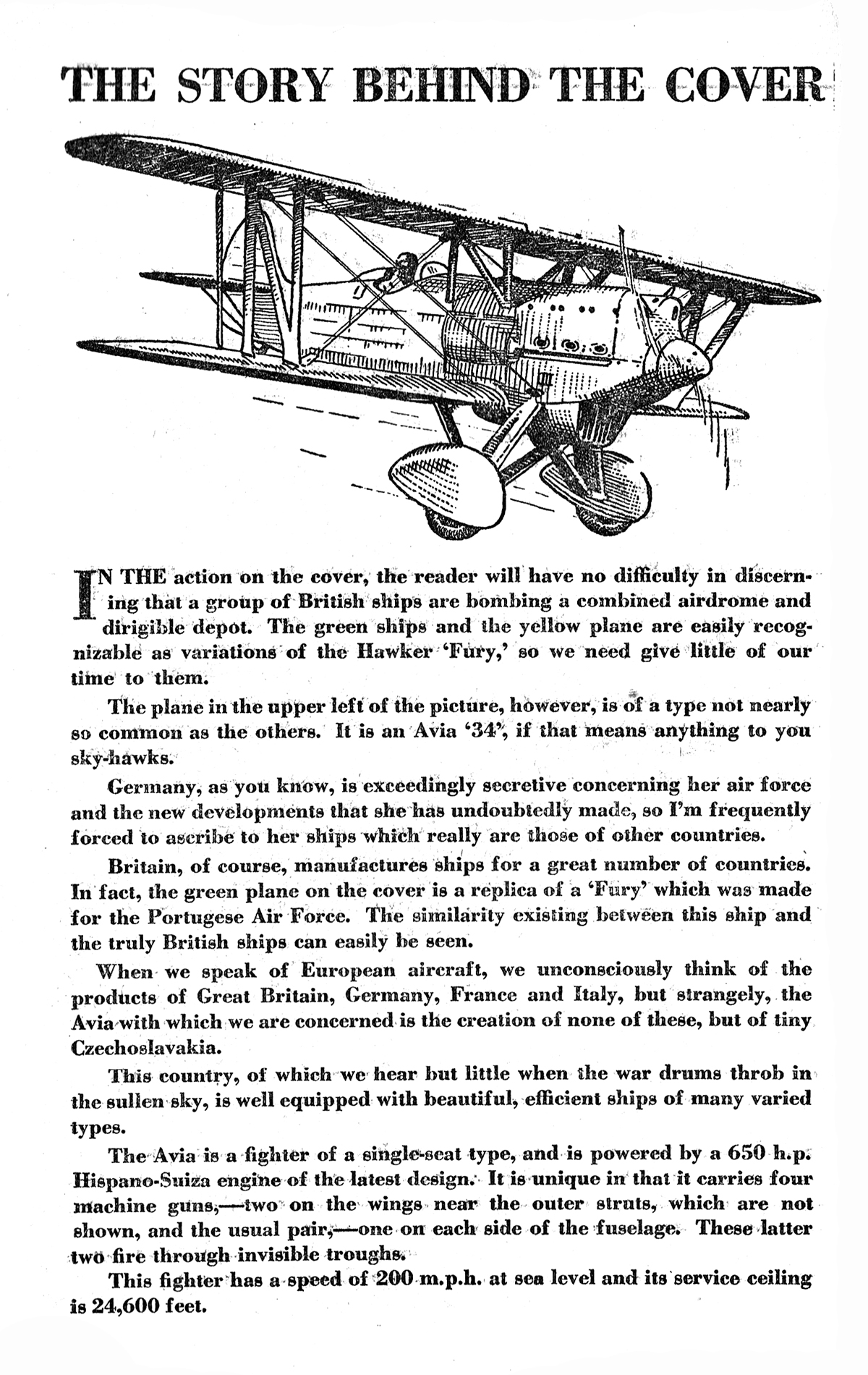
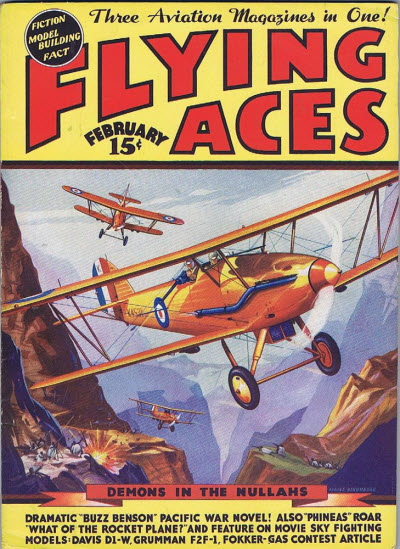 That sound can only mean one thing—that Bachelor of Artifice, Knight of Calamity and an alumnus of Doctor Merlin’s Camelot College for Conjurors is back to vex not only the Germans, but the Americans—the Ninth Pursuit Squadron in particular—as well. Yes it’s the marvel from Boonetown, Iowa himself—Lieutenant Phineas Pinkham!
That sound can only mean one thing—that Bachelor of Artifice, Knight of Calamity and an alumnus of Doctor Merlin’s Camelot College for Conjurors is back to vex not only the Germans, but the Americans—the Ninth Pursuit Squadron in particular—as well. Yes it’s the marvel from Boonetown, Iowa himself—Lieutenant Phineas Pinkham! 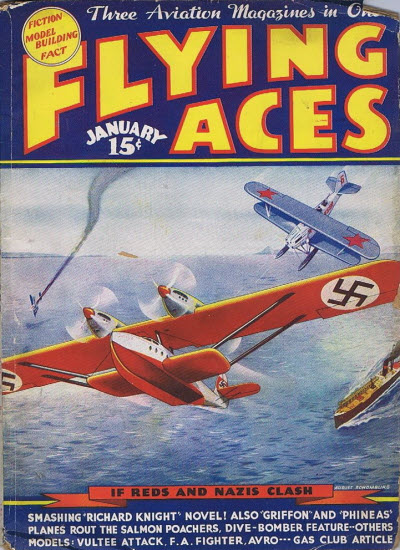 That sound can only mean one thing—it’s time to ring out the old year and ring in the new with that Bachelor of Artifice, Knight of Calamity and an alumnus of Doctor Merlin’s Camelot College for Conjurors—Phineas Pinkham.
That sound can only mean one thing—it’s time to ring out the old year and ring in the new with that Bachelor of Artifice, Knight of Calamity and an alumnus of Doctor Merlin’s Camelot College for Conjurors—Phineas Pinkham. 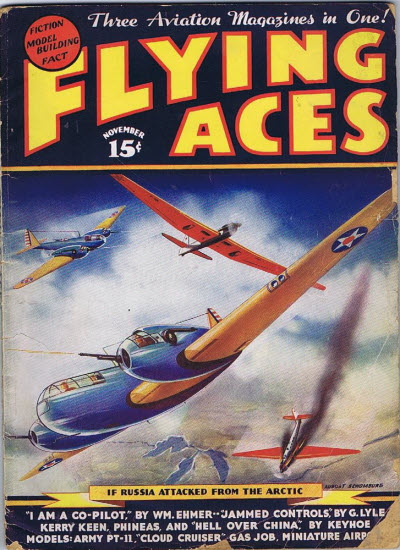 had a story in a majority of the issue of Flying Aces from his first in January 1930 until he returned to the Navy in 1942. Starting in August 1931, they were stories featuring the weird World War I stories of Philip Strange. But in November 1936, he began alternating these with sometime equally weird present day tales of espionage Ace Richard Knight—code name Agent Q. After an accident in the Great War, Knight developed the uncanny ability to see in the dark. Aided by his skirt-chasing partner Larry Doyle, Knights adventures ranged from your basic between the wars espionage to lost valley civilizations and dinosaurs. In their seventh outing from the pages of the November 1937 issue of Flying Aces, Knight and Doyle are sent to China and find themselves embroiled in a dramatic oriental sky mystery confronted by a death-ray that destroys all in it’s path! Can Agent “Q” avoid a mutated death within that eerie ray as he faces “Death Over China!”
had a story in a majority of the issue of Flying Aces from his first in January 1930 until he returned to the Navy in 1942. Starting in August 1931, they were stories featuring the weird World War I stories of Philip Strange. But in November 1936, he began alternating these with sometime equally weird present day tales of espionage Ace Richard Knight—code name Agent Q. After an accident in the Great War, Knight developed the uncanny ability to see in the dark. Aided by his skirt-chasing partner Larry Doyle, Knights adventures ranged from your basic between the wars espionage to lost valley civilizations and dinosaurs. In their seventh outing from the pages of the November 1937 issue of Flying Aces, Knight and Doyle are sent to China and find themselves embroiled in a dramatic oriental sky mystery confronted by a death-ray that destroys all in it’s path! Can Agent “Q” avoid a mutated death within that eerie ray as he faces “Death Over China!”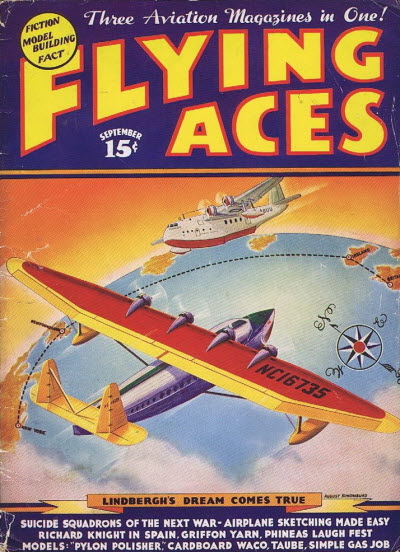 had a story in a majority of the issue of Flying Aces from his first in January 1930 until he returned to the Navy in 1942. Starting in August 1931, they were stories featuring the weird World War I stories of Philip Strange. But in November 1936, he began alternating these with sometime equally weird present day tales of espionage Ace Richard Knight—code name Agent Q. After an accident in the Great War, Knight developed the uncanny ability to see in the dark. Aided by his skirt-chasing partner Larry Doyle, Knights adventures ranged from your basic between the wars espionage to lost valley civilizations and dinosaurs. Still in Spain, Richard Knight heads back into war-torn Spain in an effort to retrieve the Green Madonna—only to find The Hawk has kidnapped Benita Navarre!
had a story in a majority of the issue of Flying Aces from his first in January 1930 until he returned to the Navy in 1942. Starting in August 1931, they were stories featuring the weird World War I stories of Philip Strange. But in November 1936, he began alternating these with sometime equally weird present day tales of espionage Ace Richard Knight—code name Agent Q. After an accident in the Great War, Knight developed the uncanny ability to see in the dark. Aided by his skirt-chasing partner Larry Doyle, Knights adventures ranged from your basic between the wars espionage to lost valley civilizations and dinosaurs. Still in Spain, Richard Knight heads back into war-torn Spain in an effort to retrieve the Green Madonna—only to find The Hawk has kidnapped Benita Navarre!